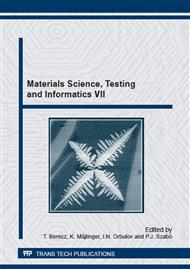[1]
Z. L. Wang, Nanostructures of zinc oxide, Mat. Today, 7 (2004) 26-33.
Google Scholar
[2]
G. Gordillo, New materials used as optical window in thin film solar cells, Surf. Rev. and Let., 9 (2002) 1675-1680.
DOI: 10.1142/s0218625x02004207
Google Scholar
[3]
M.D. Driessen, T. M. Miller, V.H. Grassian, Photocatalyticoxidation of trichloroethylene on zinc oxide: characterization of surface-bound and gas-phase products and intermediates with FT-IR spectroscopy, J. of Molec. Cataly. A: Chemical, 131 (1998).
DOI: 10.1016/s1381-1169(97)00262-8
Google Scholar
[4]
S. Music, D. Dragcevic, M. Maljkovic, S. Popovic, Influence of chemical synthesis on the crystallization and properties of zinc oxide, Mater. Chem. and Phys, 77 (2003) 521-530.
Google Scholar
[5]
A. Erxleben, Structures and properties of Zn(II) coordination polymers, Coord. Chem. Rev., 246 (2003) 203-228.
DOI: 10.1016/s0010-8545(03)00117-6
Google Scholar
[6]
S-L. Zheng, M-L. Tong, X. -M Chen, Silver (I)-hexamethylenetetramine molecular architectures: from selfassembly to designed assembly, Coord. Chem. Rev., 246 (2003) 185-202.
DOI: 10.1016/s0010-8545(03)00116-4
Google Scholar
[7]
H. Zhang, D.R. Yang, X. Y Ma, N. Du, J. B. Wu, D.L. Que, Straight and thin ZnO nanorods: Hectogram-scale synthesis at low temperature and cathodoluminescence. J. Phys. Chem. B 110 (2006) 827–830.
DOI: 10.1021/jp055351k
Google Scholar
[8]
S. Xu, et al., Patterned growth of vertically aligned ZnO nanowire arrays on inorganic substrates at low temperature without catalyst, J. of Ameri. Chem. Soci. 130 (2008) 14958–14959.
DOI: 10.1021/ja806952j
Google Scholar
[9]
K. Govender, D. S. Boyle, P.B. Kenway, P. O'Brien, Understanding the factors that govern the deposition and morphology of thin films of ZnO from aqueous solution, J. of Mat. Chem. 14 (2004) 2575–2591.
DOI: 10.1039/b404784b
Google Scholar
[10]
S. Xu, N. Adiga, S. Ba, T. Dasgupta, C.F. J. Wu, Z. L. Wang, Optimizing and improving the growth quality of ZnO nanowire arrays guided by statistical design of experiments, ACS Nano 3 (2009) 1803–1812.
DOI: 10.1021/nn900523p
Google Scholar


